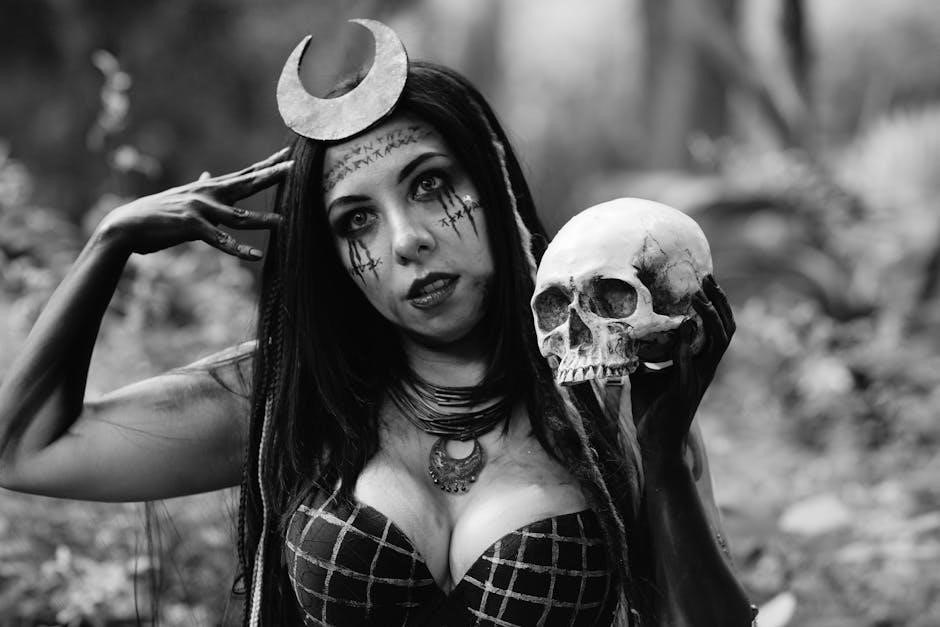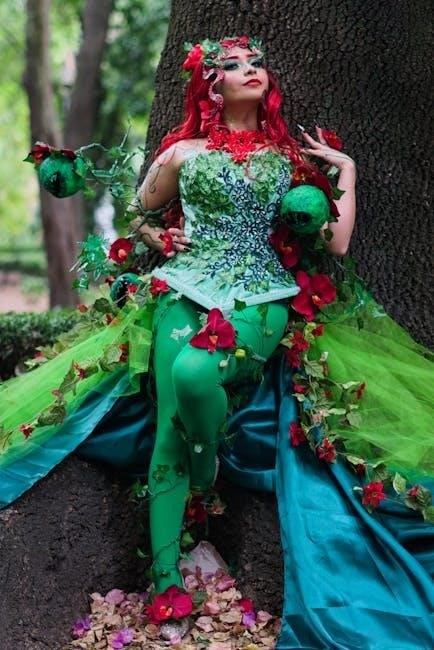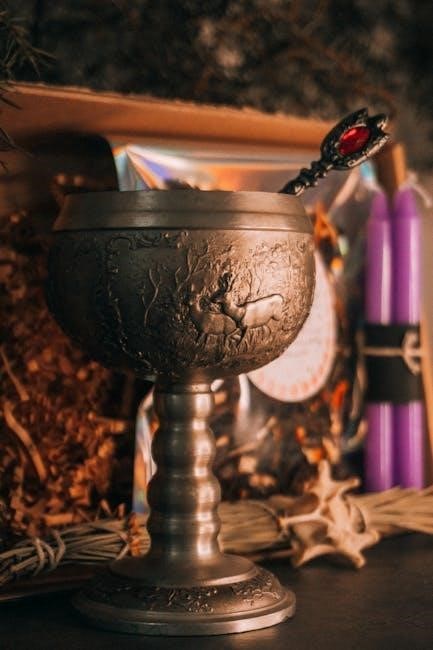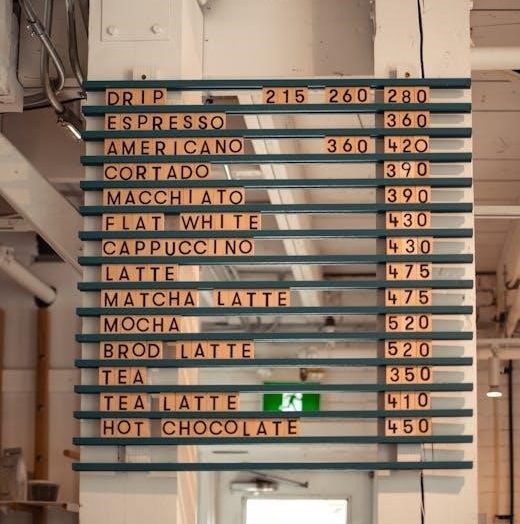Official 5e Magic Item Prices

The DMG provides base prices for magic items, while XGE offers updated pricing guidelines and additional items for balanced gameplay in 5e.
1.1. Dungeon Master’s Guide (DMG) Guidelines
The DMG provides foundational guidelines for pricing magic items in 5e, categorizing them by rarity (Common, Uncommon, Rare, etc.) and offering base costs. These prices serve as benchmarks for DMs to award items fairly, ensuring game balance. The DMG also details how item rarity correlates with power level and availability, influencing their value. For instance, a Common item like a magic stone might cost 25 gp, while a Rare item like a cloak of protection costs 1,000 gp. These guidelines help DMs adjudicate item distribution and create balanced encounters. However, prices can vary based on campaign settings, such as Forgotten Realms or Greyhawk, where regional supply and demand alter costs. The DMG’s pricing system is a critical tool for maintaining economic consistency in any 5e campaign.
1.2. Xanathar’s Guide to Everything (XGE) Updates
Xanathar’s Guide to Everything (XGE) introduces updated pricing guidelines and new magic items, refining the DMG’s system for better balance. It provides clarified rules for item creation, including costs for materials and enchantment times, ensuring consistency. For example, XGE specifies that creating a wand of fireballs requires 1,500 gp in materials and 30 days of work. Additionally, XGE offers optional rules for item distribution and pricing variations based on rarity tiers. These updates help DMs create custom items and adjust prices to fit their campaigns, enhancing gameplay. XGE’s adjustments ensure that magic items remain balanced without overshadowing character abilities, making it a valuable resource for 5e campaigns.
1.3. Specific Magic Items and Their Prices in the DMG
The DMG details specific magic items with their respective prices, aiding DMs in balancing treasure. For instance, the Ring of Protection costs 15,000 gp, offering a +1 bonus to AC and saving throws. The Wand of Magic Missiles is priced at 2,250 gp, providing reliable damage. These items are categorized by rarity, influencing their cost and power. The DMG also lists consumables like Potions of Healing at 50 gp each, offering immediate benefits. Additionally, artifacts like the Deck of Many Things are priced at 100,000 gp, reflecting their immense power. These prices serve as benchmarks, helping DMs determine fair values for other items, ensuring balanced gameplay and exciting treasure distribution in 5e campaigns. This system provides clarity for both new and experienced DMs, enhancing their world-building efforts.

Homebrew Magic Item Prices

Homebrew magic items allow creators to craft unique treasures, but pricing them requires balancing creativity with gameplay fairness to maintain equilibrium in 5e campaigns and adventures.
2.1. Community-Created Magic Items and Their Pricing
Community-created magic items offer unique twists, but pricing them can be challenging. Creators often reference official guidelines while adding innovative mechanics. Playtesting ensures balance, preventing overpowered or underpriced items.
2.2. Balancing Homebrew Items with Official Prices
Homebrew items should align with official prices to maintain game balance. Compare similar items from the DMG and XGE, adjusting for unique abilities. Playtesting helps refine costs, ensuring fairness and fun.

Pricing Factors for Magic Items
Factors include rarity, item level, materials, crafting costs, and whether items are consumable or permanent. Enchanted items typically cost more than non-enchanted ones.
3.1. Rarity and Its Impact on Price
Rarity significantly influences magic item prices in 5e. Common items are affordable, while Legendary items are exceedingly rare and costly. Uncommon, Rare, and Very Rare items fall in between, priced according to their power and availability. The DMG provides specific rarity-based price ranges, helping DMs balance treasure distribution. For instance, a Common item like a Potion of Healing is cheap, whereas a Legendary item such as The Eye of Vecna is priceless. Rarity ensures that powerful items remain exclusive, maintaining game balance. This system helps DMs create engaging treasure hoards without breaking the economy.
3.2. Item Level and Cost Correlation
In 5e, the cost of magic items strongly correlates with their power level and rarity. The Dungeon Master’s Guide (DMG) and Xanathar’s Guide to Everything (XGE) provide tables and guidelines for pricing based on item levels. Lower-level items, such as 1st-level or 2nd-level magical gear, are more affordable and accessible. As the item level increases, so does its cost exponentially, reflecting its enhanced capabilities. For example, a 9th-level item like a Wish is among the most expensive due to its immense power. This correlation ensures that powerful items remain rare and balanced, preventing early access to overpowered gear. The system also helps DMs assign appropriate values to custom items, maintaining game equilibrium.
3.3. Materials and Crafting Costs
Materials and crafting costs significantly influence the price of magic items in 5e. Rare and exotic materials, such as dragon scales or unicorn horns, can drastically increase an item’s value. Crafting time also plays a role, as creating powerful items often requires months of work by skilled artisans. The DMG and XGE provide guidelines for estimating these costs, suggesting that items crafted from precious metals or enchanted components are inherently more expensive. Additionally, the expertise of the crafter can affect the final price, with masterful workmanship commanding higher fees. These factors ensure that magic items are not only balanced in power but also reflect the resources and effort invested in their creation, making them rare and valuable treasures in any campaign.
3.4. Enchanted vs. Non-Enchanted Items
Enchanted items in 5e are distinctly more valuable than their non-enchanted counterparts due to the magical properties they possess. The process of enchantment requires specific materials, time, and expertise, which directly impacts their pricing. Non-enchanted items, such as mundane weapons or armor, are typically priced based on their material quality and craftsmanship alone. In contrast, enchanted items often include additional costs related to spellcasting components, rare materials, and the skill of the enchanter. This differentiation ensures that enchanted items remain scarce and highly sought after, maintaining game balance and encouraging strategic resource management among players. The DMG and XGE provide detailed pricing guidelines to help distinguish between these categories, ensuring consistency across campaigns.
3.5. Consumable vs. Permanent Items
Consumable and permanent magic items differ significantly in pricing due to their durability and usage limits. Consumables, such as potions, scrolls, and wands, are priced lower because they provide temporary benefits and are expended after use. Permanent items, like magical weapons or armor, retain their abilities indefinitely, making them far more valuable. The cost of consumables often reflects their spell level, rarity, and materials, while permanent items are priced based on their power, rarity, and crafting complexity. This distinction ensures that players and DMs can balance the economy, with consumables offering flexibility and permanent items serving as long-term investments. The DMG and XGE provide clear guidelines to help determine fair prices for both categories, maintaining game balance and encouraging strategic decision-making.

Determining Custom Magic Item Prices
Custom magic items should be priced based on spell level, rarity, and item level, ensuring balance with official guidelines and gameplay fairness.
4.1. Guidelines for Creating Balanced Prices
When creating custom magic item prices, start by consulting official 5e sources like the DMG and XGE for baseline values. Assess the item’s spell level, duration, and effect to determine its potency. Compare it with similar items in terms of rarity and functionality. Ensure prices align with the item’s intended rarity and power level. Playtesting is crucial to refine and adjust prices based on gameplay impact. Use community tools and calculators to cross-reference and validate your pricing. Balancing affordability and power prevents disrupting game economy. Transparency with players about pricing logic fosters trust and fairness. Regularly review and update prices as new content emerges.
4.2. Playtesting and Adjusting Prices
Playtesting is essential for refining magic item prices. Introduce custom items in low-stakes scenarios to observe player interactions and item effectiveness. Gather feedback on perceived value and balance. Adjust prices based on whether items are underused or overpowered. Overpriced items may see reduced demand, while underpriced ones could destabilize the economy. Iterate on pricing through multiple sessions to ensure fairness. Consider party composition and campaign difficulty when tweaking costs. Log player feedback and item performance to track changes. Use this data to fine-tune prices for optimal game balance. Regular updates ensure items remain relevant without disrupting the game’s economy. Playtesting is an ongoing process to maintain harmony in your campaign’s magic item ecosystem.
4.3. Examples of Custom Magic Items and Their Prices
Custom magic items like the Starlight Cloak (uncommon, 800 gp) grant resistance to radiant damage and advantage on Charisma checks under moonlight. The Earthforged Gauntlets (rare, 2,500 gp) allow Strength saves to reroll once per day. These items balance utility and power; The Whispering Dart (common, 100 gp), a consumable, guarantees a critical hit on a d20 roll of 19-20. Pricing reflects rarity, with uncommon items like the Mana Crystal (500 gp) providing spell storage. Rare items like the Spellstealer’s Ring (3,000 gp) allow stealing spells. Each item’s price aligns with its potential impact, ensuring balanced integration into campaigns. These examples demonstrate how to create and price unique items while maintaining game equilibrium.

Magic Item Prices in Different Campaign Settings
Magic item prices vary across settings like Forgotten Realms and Greyhawk, influenced by local demand, cultural norms, and availability of enchanted goods.
5.1. Forgotten Realms vs. Greyhawk Pricing
Magic item prices differ significantly between Forgotten Realms and Greyhawk due to regional demand and cultural influences. In Forgotten Realms, cities like Waterdeep and Baldur’s Gate drive higher prices due to their bustling markets and high demand for magical goods. Conversely, Greyhawk’s more centralized economy and focus on scholarly pursuits often result in slightly lower prices for common items, though rare artifacts may fetch premium prices; The availability of enchanted materials and local crafting traditions also play a role, with Forgotten Realms’ diverse regions offering a wider variety of magical items at varying costs. These differences highlight how setting-specific economics shape the value of magic items in 5e campaigns.
5.2. Regional Variations in Magic Item Costs
Magic item prices vary significantly across different regions in 5e campaigns, influenced by local culture, availability of resources, and demand. In Eberron, the emphasis on industrial magic can lower prices for common arcane items, while rare artifacts remain costly. Dragonlance settings often see fluctuating prices due to wartime demands and limited supply. In contrast, Ravenloft’s dark themes may inflate prices for protective or divination magic, as such items are highly sought after for survival. These regional differences encourage DMs to tailor magic item economies to their campaign’s lore, creating unique shopping experiences for players and enriching the game’s immersion and balance.

Magic Item Economics in 5e
- Supply and demand heavily influence magic item prices.
- NPCs and merchants control trade dynamics and availability.
- Crafting and enchanting costs impact market value significantly.
6.1. Supply and Demand in the Magic Item Market
In the 5e economy, magic item prices are shaped by supply and demand. Rare and powerful items, like artifacts, are scarce and highly sought after, driving up costs. Conversely, common items such as potions and scrolls are more accessible, leading to lower prices. The difficulty in crafting these items also influences demand; complex enchantments require rare materials and skilled artisans, limiting supply. Regional variations further affect pricing, as certain areas may have abundant magical resources while others face shortages. Additionally, the presence of adventurers and their constant need for magical tools create consistent demand, stabilizing prices in bustling campaign settings like the Forgotten Realms. This dynamic ensures the magic item market remains fluid and responsive to in-game economics.
6.2. The Role of NPCs and Merchants
NPCs and merchants significantly influence magic item prices in 5e. Merchants often set prices based on rarity, demand, and regional availability, as outlined in the DMG and XGE. Powerful NPCs, such as wizard enclaves or noble collectors, may drive up costs by seeking rare items, creating scarcity. Conversely, some merchants might lower prices to attract adventurers or eliminate surplus stock. Haggling is a common tactic, allowing players to negotiate better deals, especially in bustling markets. Additionally, black market traders may offer discounted prices for stolen or illicit items, introducing ethical dilemmas. These interactions add depth to the economy, making magic item acquisition feel dynamic and immersive, while also reflecting the broader campaign setting’s tone and rules. This variability ensures no two transactions are ever the same, enriching gameplay and storytelling opportunities for both players and DMs alike. Regional pricing disparities further emphasize the importance of merchant and NPC roles in shaping the magic item market.
6.3. Haggling and Negotiation Tactics
Haggling is a key aspect of acquiring magic items in 5e, allowing players to negotiate prices with merchants. The DMG suggests using Wisdom (Insight) or Charisma (Persuasion) checks to determine negotiation success. Offering rare goods, providing services, or appealing to a merchant’s motivations can lower prices. Conversely, urgency or limited supply may prevent haggling. Some merchants, especially in bustling cities, expect negotiations, viewing it as a game. Others, like temple priests, may be less inclined to haggle. Players must balance their offers to avoid offending sellers, as overly aggressive tactics can harm relationships. Successful haggling not only reduces costs but also enhances immersion and rewards social interaction skills. This dynamic system encourages creative problem-solving and enriches the game’s economic and social dynamics, making each transaction unique and engaging. It also reflects the campaign’s tone, whether it’s a high-fantasy or gritty setting, adding layers to the narrative and player interactions. By mastering negotiation tactics, players can optimize their resources and influence the game world effectively.

Resources for Magic Item Prices
Official 5e sourcebooks like DMG and XGE provide detailed pricing guidelines. Community tools, such as online calculators, and forums offer additional resources for price comparisons and balanced gameplay.
7.1. Official 5e PDFs and Sourcebooks
Official 5e PDFs, such as the Dungeon Master’s Guide (DMG) and Xanathar’s Guide to Everything (XGE), provide comprehensive pricing guidelines for magic items. These sourcebooks are essential for understanding base costs, rarity, and item levels. The DMG includes detailed tables and explanations for determining prices, while XGE expands on these rules with additional items and clarifications. Both resources are widely regarded as the primary references for magic item pricing in 5e. They also offer examples of specific items, such as Winged Boots and Brooms of Flying, with their respective prices. Regular updates and errata ensure the pricing remains balanced and consistent across campaigns. These official PDFs are indispensable for DMs and players seeking accurate and reliable pricing information.
7.2. Community Tools and Calculators
Community-created tools and calculators are invaluable for determining magic item prices in 5e. Online resources, such as the popular D&D Beyond Magic Item Prices Calculator, allow users to compare official prices from sourcebooks like the DMG and XGE. These tools often include filters for rarity, item level, and specific item types, making it easier to find accurate pricing. Some calculators even enable players and DMs to estimate costs for homebrew items based on their effects. Websites like DandWiki and EnchantedItemCalculator provide detailed breakdowns of material costs and enchantment levels. These tools are regularly updated by the community to reflect new items and balance changes, ensuring they remain relevant for both casual and competitive play.
7.3. Online Forums and Discussions
Online forums like Reddit’s r/DnD and EN World are hubs for discussing magic item prices in 5e. Players and DMs share insights, debate pricing strategies, and post examples of custom items. These communities offer diverse perspectives, from optimizing treasure hoards to balancing homebrew creations.Threads often link to official PDFs and tools, providing practical resources. Discussions highlight regional price variations and NPC merchant behaviors, enriching campaign settings. Veteran DMs share tips on haggling and negotiation, adding depth to in-game economies. These forums foster collaboration, helping users refine their approaches to pricing and item design, ensuring content is both fun and balanced for all players.

Common Mistakes in Pricing Magic Items
Overpricing can make items unattainable, while underpricing disrupts game balance. Both extremes often stem from ignoring official guidelines and failing to playtest items thoroughly.
8.1. Overpricing and Its Consequences
Overpricing magic items can make them inaccessible to players, frustrating character development and limiting gameplay opportunities. This often occurs when creators ignore official guidelines or fail to consider an item’s rarity, potency, and demand. Excessive pricing disrupts campaign balance, as players may feel forced to prioritize wealth over story or mechanics. Additionally, overpriced items can lead to inflation in the in-game economy, making other goods and services seem devalued. It’s crucial to reference official 5e sources, such as the DMG or XGE, and playtest items to ensure fair pricing. Overpricing not only alienates players but also undermines the immersive experience of the game world.
8.2. Underpricing and Game Balance Issues
Underpricing magic items disrupts game balance by making powerful items too accessible, potentially overshadowing less powerful ones. This can lead to players amassing items that grant them unintended advantages, breaking the game’s difficulty curve. NPCs and merchants may lose their economic relevance if items are undervalued, diminishing their role in the story. Furthermore, underpriced consumables or permanent items can create an imbalance in party dynamics, as some players gain excessive benefits at minimal cost. It’s essential to use official guidelines from the DMG and XGE to set realistic prices, ensuring items remain tools for storytelling rather than game-breaking elements. Playtesting and player feedback are vital to maintaining a balanced economy.
Magic item pricing in 5e requires careful balancing, using DMG and XGE guidelines to ensure fair gameplay and maintain the game’s economy and fun.
9.1. Final Thoughts on Magic Item Prices in 5e
Magic item pricing in 5e is a delicate balance between game mechanics and narrative value. The DMG and XGE provide foundational guidelines, but homebrew items require careful consideration. Prices should reflect rarity, power, and availability to maintain game balance. Overpricing or underpricing can disrupt the economy and player satisfaction. Community tools and calculators offer helpful frameworks, but DMs must adapt to their campaign’s unique needs. Ultimately, consistency and fairness are key to ensuring magic items enhance, rather than overshadow, the game. By leveraging official resources and playtesting, DMs can create meaningful and balanced magic item economies that enrich their worlds.
9.2. Future Considerations for Magic Item Pricing
Future updates to 5e may refine magic item pricing, incorporating community feedback and new content. Expanding the range of item rarities and introducing region-specific pricing could add depth. Digital tools and calculators will likely play a larger role, streamlining custom item creation. Additionally, exploring the economic impact of magic items on campaign settings could offer fresh dynamics. As homebrew content evolves, balancing prices while maintaining game integrity will remain crucial. By embracing innovation and adaptability, the system can ensure magic items continue to inspire creativity without disrupting gameplay. These advancements will help keep 5e vibrant and engaging for years to come.
